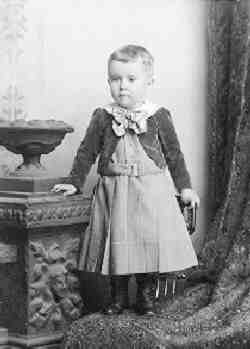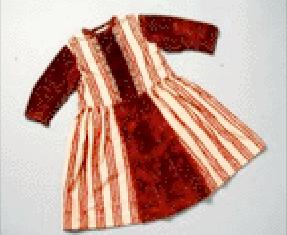
Dresses for Boys during the Late-19th Century: Styles and Colors

Figure 1.--In the late 19th Century dress styles developed specifically for boys. They were generaly styled more simply than girl's dresses. Boys' dresses also more commonly employed a belt as a stylistic feature. This boy wears his dress with a velvet jacket and bow.
|
It should be emphasized that in this section we are talking about actual dresses and not skirted garmets like kilts and kilt suits. Kilt suits were very popular in the late 19th century. The fashion of kilts for boys was given great empetus when Queen Victoria dressed the young princes in kilts. Kilt suits were, however, often rather boyish looking garmets with jackets that could have been just as easily worn with kneepants. Kilts differed from dresses in that the materials used were more limited. There is often a clearly separated skirt (although little boy kilts usually were bodice kilts. Dresses on the other hand are one-piece garmets.
Dresses in the late 19th century were still worn by children of both genders. Somegender-based stylistic differences were becoming more apparent, especially by the 1890s. Girls' dresses often buttoned in the back while a boy's dress buttoned in the front--but there were no definitive rule. The use of hand me downs futher complicated who wire what. Mych was left to the mother's discression. The Mint Museum of Art in 1999 sponsored an exhibit on Children's Fashions from the Nineteenth Century. On display was s a young boy's dress with a rosette "bustle" purchased in 1879 in Chicago for 4-year old James Cromwell. The Museum reports, "Such garments were worn over flounced petticoats with lace-trimmed pantalets or knee-length trousers beneath. Dresses for young girls imitated adult versions, often requiring corsets. Short skirts were also characteristic as seen in a highly structured young girl's dress circa 1880-1885."

Figure 2.--The dresses worn by boys were not as elaborate as those worn by their sisters, but like this 1888 dress, they were more colorful than the suits worn by older boys.
|
Colors
Much of our knowldge of the dresses worn by boys is based on black and white photography. The dresses worn by boys, however, were more colorful than the suits they wore. A color photograph of a boy's dress worn in the American mid-west during 1888 can be seen at The dress is a tan cotton twill with burgundy "boucle" yarn stripes, colorful burgundy velveteen panels on sleeves, chest, and back (bodice and skirt).Decorative metal buttons on front and back bodice, 18 each side.
Material
Themes
Some dresses were made with a variety of themes. These indluded the popular sailor style as well asva variety of fanciful styles, including Fauleroys, Scottish, Zouave and others. Some of these styles had military themes in an effort to appeal
to boys. But even the dresses with military themes might have some very non-military embelishments, including ruffles and lace.
Fauntleroy: The most destinctive fancy theme dress in the
late-19th Century were
dresses in the Fauntleroy style. These were often plain velvet dresses with fancy lace
collars and matching wrist cuffs.
Sailor: One of the more common theme style were dresses with varying degrees of
sailor suit styling. Often fancy details with lace and ruffles were added. Even more
commom were the sailor tunics worn with knickers at the turn of the century.
Zouave: Outfits styled like Zouave uniforms were popular in America during the
1860s and 70s, but were less common ny the 1880s. They may have been worn in France also,
but I'm less sure about that.
Other fancy: Dresses were made in a variety
of other fancy styles.
Actual Dresses
Some actual dresses from the late 19th Century have survived and exist now in individual
collections or as museum pieces. They of course provide a great deal of information on
both color, style, and material.
Christopher Wagner

Navigate the Historic Boys' Clothing Web chronological pages:
[The 16th century]
[The 17th century]
[The 18th century]
[Mid-18th century]
[Late-18th century]
[The 1800s]
[The 1810s]
[The 1820s]
[The 1830s]
[The 1840s]
[The 1850s]
[The 1860s]
[The 1870s]
[The 1880s]
Navigate the Historic Boys' Clothing Web dress pages:
[Return to the Main dress page]
[Pinafores]
[Sausage curls]
[Smocks]
[Bodice kilts]
[Kilts]
[Fauntleroy dresses]
[Sailor dresses]
[Fancy dresses]
[Dresses: 17th century]
[Dresses: 18th century]
[Dresses: Early-Mid-19th century]
[Dresses: Late-19th century]
[Dresses: Early 20th century]
[Difficult images]
[Movie dresses]
Navigate the Boys' Historical Clothing Web Site:
[Introduction]
[Activities]
[Biographies]
[Chronology]
[Clothing styles]
[Countries]
[Bibliographies]
[Contributions]
[FAQs]
[Glossaries]
[Satellite sites]
[Tools]
[Boys' Clothing Home]

Created: November 30, 1998
Last updated: June 24, 2002



